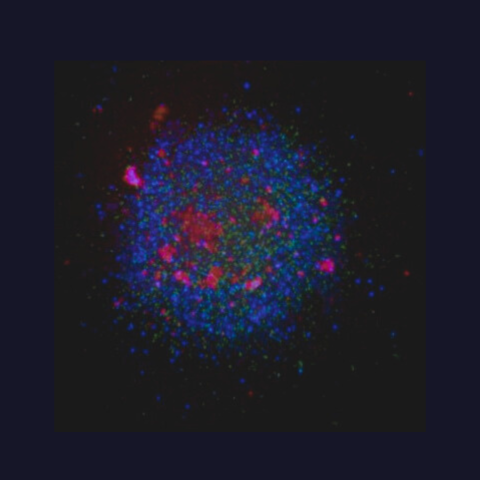
An image of tumor cells (red), immune cells (blue), and dead cells (green) after STAR0602 was added in a 3D in vitro organoid culture from a human tumor. CREDIT: Jonathan Hsu et al.
In a mouse study, researchers have discovered a novel way to boost the ability of immune cells to attack tumors, leading to long-lasting anti-tumor activity with very little toxicity. The study, published in Science Translational Medicine on November 29, 2023, showed that activation of a unique class of human and mouse T cells resulted in strong anti-tumor activity against six different types of cancer in mice. This finding has prompted the launch of a new clinical trial in humans.
T cells are the primary immune cells tasked with killing cancer. They are stimulated via a molecule called the T-cell receptor (TCR), but this sometimes results in the release of inflammatory molecules called cytokines, which can be harmful to nearby healthy tissues and cause unpleasant side effects. Scientists have been keen to find ways of stimulating T cells while reducing the widespread release of cytokines.
This conundrum prompted researchers at Marengo Therapeutics, Cambridge, Massachusetts, to create a new therapeutic molecule called STAR0602 that includes a novel antibody combined with an immunotherapy agent called interleukin-2 (IL-2). The antibody binds to one type of T-cell receptor that helps stimulate T-cell activity, while IL-2 stimulates the expansion and sustained action of T cells. By combining these two molecules in the bifunctional STAR0602, the researchers hoped to bring IL-2 directly to T cells in a way that reduces side effects but still incites potent anti-tumor activity.
The team at Marengo Therapeutics partnered with Jeffrey Schlom, Ph.D., and James L. Gulley, M.D., Ph.D., Co-Directors of the Center for Immuno-Oncology, and their colleagues to test the novel therapy further and better understand its mechanisms. The scientists studied a version of STAR0602 formulated for mice in six different mouse models, which included lung, liver, head and neck, renal and breast cancers, as well as melanoma. After 24 days, all six groups experienced tumor shrinkage ranging from 57% to 98% and exhibited increased survival compared to mice treated with a placebo or a commonly used immunotherapy called anti-PD-1 therapy.
“In all the mouse models studied, the STAR agent–induced anti-tumor activity led to the elimination of many tumors, and the anti-tumor activity was durable,” Schlom says. When rechallenged with additional tumors, the mice retained their strong anti-tumor response and continued to experience tumor shrinkage.
In experiments led by Renee Donahue, Ph.D., in Schlom’s lab, STAR0602 was also shown to promote the expansion of human T cells directed against the human papillomavirus (HPV), which is associated with several other types of cancers, such as cervical cancer.
These results have led to the launch of a new clinical trial testing STAR0602 in humans, which is being led by Gulley. “STAR0602 causes a phenotypically and functionally unique activation of a subset of T cells which leads to anti-tumor activity in mouse models,” he says. “In our ongoing clinical trial, we are eager to see if we can harness this novel T-cell activation to generate meaningful clinical responses in patients with advanced cancer.”